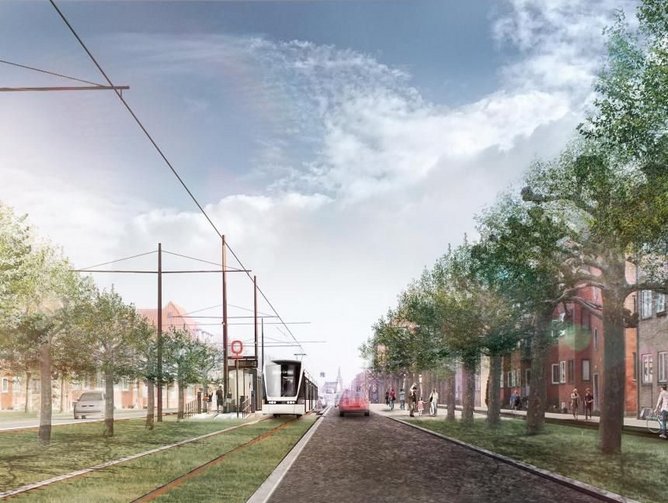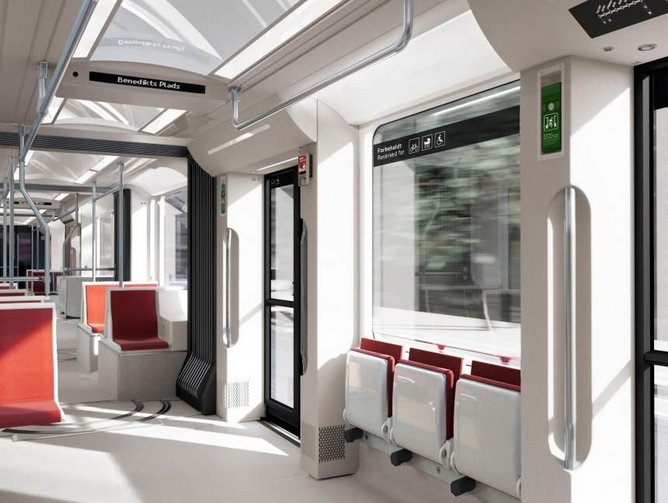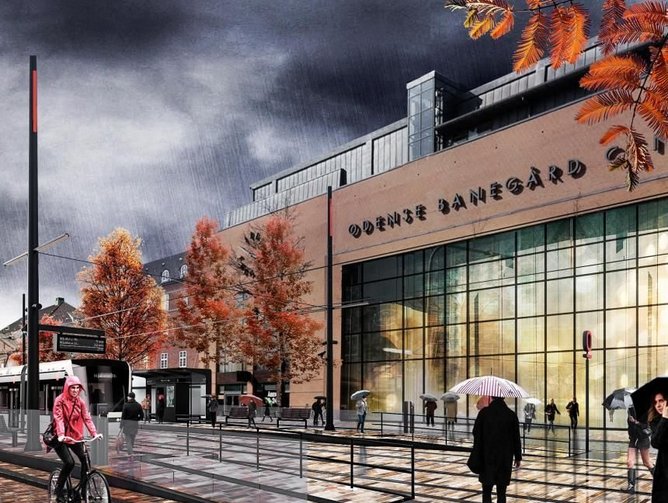Odense Letbane: Delivering the first ever light rail in Denmark’s third city
Europe has an extensive number of tramway networks, although Melbourne in Australia boasts ownership of the world’s largest tram system. All the former communist countries of Central and Eastern Europe, excluding Lithuania, the Republic of Macedonia, Montenegro, Moldova and Slovenia, have extensive tram infrastructures. Many cities closed their tram programmes last century due to the rapid increase in traffic. However, in recent decades, tram networks in countries including the UK, Ireland, France, Germany, Spain and Portugal have grown considerably.
Denmark is the latest country to re-embrace the tram – 45 years since the last tram ran in Copenhagen, a new tram system is being constructed in Odense, in addition to one in Aarhus. Following the Odense Letbane Construction Act in spring 2015, the construction company Odense Letbane P / S was established. It is 100% owned by Odense Municipality, but acts as an independent company.
Perhaps most famous as the birthplace of the author Hans Christian Andersen, Odense is hoping to become a global leader in sustainability. “It is a very green city and a very blue city as well,” acknowledges Mogens Hagelskær, CEO at Odense Letbane. “Of course, from an environmental point of view, we are obligated to look into how can we reduce the CO2 or emissions in any way. How can we re-use braking energy? How can we utilise solar cells on top of the roof of the control room centre?”
A Danish city on the rise
The tram system is part of a wider regeneration scheme in Odense after the city was hit hard by the global financial crisis. “15 years ago, there were a lot of industrial areas in Odense but due to the financial crisis they were closed,” explains Hagelskær.
“The former Mayor and CEO of the municipality, together with the city council, decided that instead of just slicing their way out of it by cost cutting, they wanted to invest in the city.” The planned total investment in urban development from 2012 to 2022 is DKK 44bn (US$6.8bn). As a result of this, 38,000 new temporary jobs and 10,000 new permanent jobs will be created.
US$6.8bn may be a small amount compared many other projects – London’s Crossrail project is scheduled to cost US$23bn – but in Danish terms, it is a considerable investment. “Odense is moving from a medium sized city to a great city in Denmark,” Hagelskær notes. “It's not only enough to have a city. You need culture, you need sports, you need good shopping and restaurants, you need education, you need transport.
“All these things are handled in the one big overall strategy of getting to a greater city and they are all projects attacking the same three principals – that is attraction, growth and transformation of the city. Of course, from our perspective, the tramway is the most important project of all of them because we are combining the single strategy towards a higher scale and with the infrastructure.”
Transforming Odense
The overall strategy of making Odense a great city is one that Odense Letbane is determined not to lose sight of. “The tramway scheme in Odense is being built in four legs. It is our vision of the tram that it is supporting the overall city vision. All in Odense need to be careful because it's not the end goal to deliver a tramway. It is just a step to the end goal. The end goal is to make to transform of all of Odense,” observes Hagelskær.
To support the overall objective, Odense Letbane envisions that it will support development work in Odense generally and especially within 400m of each station. “We know that there will come a lot of investment, we see it already. We support new infrastructure and we are integrating and strengthening the public transportation infrastructure, both the existing railways and the highway,” states Hagelskær. From the public transportation point of view, Odense Letbane is also supporting and transforming the bus system.
A new identity
Like many cities, Odense is facing major transport challenges in the coming years. On the outskirts of the city, a new university hospital and science campus are under construction, and the existing university is planning to double its capacity over the next couple of years. “By 2024, we can see that more than 60,000 people on a daily basis will travel in and out of that area. That is approximately the same as a medium sized city in Denmark that needs to go in and out of an area. We cannot do that with the existing infrastructure,” acknowledges Hagelskær.
“Second of all, we have an ambition in Denmark that it will only take one hour to come from Copenhagen to Odense and one hour from Odense to Aarhus, the second largest city in Denmark. If that is going to be realised then we will be looking at double the amount of people coming in and out of Odense station on a daily basis. That means that we will have a lot of congestion in that area.”
Many solutions to these challenges were proposed but, in the end, the tramway is the one that Odense is going with. “The tramway will carry more than four buses and more than 200 cars worth of passengers each time that it enters the stations,” Hagelskær comments. “On top of that, of course, there are a lot of extra benefits and developments that come with urban development. But actually, the core objectives and the core business case are in the capacity of the tramway.”
Lessons learned
In August 2012, the competition for the design and visualisation consultancy for the Odense tram system was won by a team consisting of Niras, PLH Architects, Atelier Villes & Paysages and MBD Design. In March 2015, Parsons Brinckerhoff won the contract for project management, and strategic and economic advice. COWI was selected as technical advisor. Following on from that, in June 2015, preparatory work began involving the city’s water and sewer pipes – work that will be hard to do once the rails are in place.
“We are actually taking a risk out for the big contractors by doing all the utilities diversions. That is from lessons learned from programmes in the UK where they have tried to do it at the same time and you are always surprised by what's happening under the road,” notes Hagelskær.
The tramway project has been split into four different construction phases. “When you look into how we're going to build the tramway, we have divided it up in a very logical way,” Hagelskær observes. After the utilities are moved, the roads, bicycle lanes and pavements will be built. Then after that the tracks, the masts and the stations. Finally, the focus will be on greenery. “We're planting one or two trees every time that we are removing one,” adds Hagelskær.
Competing on efficiency
In the beginning, Odense Letbane decided to tender out the project as DBOM – design, build, operate and maintain. However, it quickly became apparent that there would be a lack of competition, driving up prices, as few companies could deliver all that was required within the tender. It was then decided to split the civil works into individual packages, as well as packages for the transport system and the rolling stock. The contract for rolling stock has been awarded to Stadler.
“We now have divided the whole alignment in the civil works into seven smaller packages because we can see that in Denmark it was too large a scale of packages for one contractor, and we couldn't attract international civil workers or construction companies to come and do that for us,” acknowledges Hagelskær.
“To have the highest competition possible, we divided them into certain packages. We have done the detailed design so our contractors are competing on the efficiency that they will provide in the construction phase. Right now, we have tendered up five out of the seven packages and we will have received the last two packages before 1 March.”
New money
The first of 16 Variobahn trams is expected to be delivered by Stadler to Denmark in autumn 2019, while the whole fleet is scheduled to enter service by the end of 2020. Despite being almost three years away, the Odense tram project is already attracting developers to the city. “We can see already that a lot of developers are attracted to Odense, even developers we haven't seen in the city before,” Hagelskær comments.
“There’s actually new money coming into the city here, and what we see from other projects is that a tramway is a generator for growth – there will be urban development. Not only the ones that we had planned for already, but also new ones that we wouldn't have seen coming before. It means that the municipality must treat the tramway as strategic to their overall planning.”
It is hoped that investment will flow into Odense with new businesses developing along the route of the tram. In 2010, a modern tram line opened in Bergen, Norway, and Odense Letbane uses this project as a point of comparison. “At this point of time in the project, there were approximately DKK 17bn [$2.6bn] invested near to the tramway tracks and that is similar to us here in Denmark. We have approximately DKK 15bn [$2.3bn] in investment within a 400m radius of the tramway right now,” remarks Hagelskær. “The challenges that we are facing is that an urban tramway as we're building in Odense, there are very few people in Denmark with experience of building a tram like that.”
Gaining competence
This lack of experience of building tramways in Denmark has certainly been a challenge for Odense, although neighbouring countries have been sources of inspiration. “Building a tramway in the city centre, that is something new in Denmark,” Hagelskær comments. “We haven't seen that from past history, so the capacity of the competence is very high for us to gain. We do of course get a lot of inspiration from how they've done it in the UK, France, and Germany.”
In all Danish towns and cities, cycling is one of the most common means of transport. According to the country’s official website, it is estimated that there are more than four million bicycles in Denmark and more than 10,000km of designated cycle tracks and routes. As the tram system takes shape, care must be taken to manage the space available for traffic.
“The pedestrians and bicycles are using the same space as we are building on, so there's a lot of congestion. You see people are stopped in their cars but there's a lot of things that you need to balance when you're doing this. You need your alignment to work for your construction site, but you also need to take into the account that the city must function when you are doing the construction,” Hagelskær acknowledges.
Coordination and communication
There will be 26 stations on the line from Tarup in the north to Hjallese in the south. At 14.5km, the first phase of the tram system extends through much of Odense. As well as ensuring that the city can function during construction, Odense Letbane must also take into account other projects that are happening in the city.
“We need to have a lot of mutual adjustment, coordination and communication together,” explains Hagelskær, referencing the aforementioned university and hospital projects. “The city needs to be facilitators to the common investment. That means that we are actually adjusting or balancing a lot of bottom lines in a project like this. That is not a simple job to organise.”
Focused discussion
The impact that the project has on the citizens of Odense is also an important consideration for Odense Letbane, and is reflected in how the management team operates. “We are very focused on the fact we are dealing with other people's money. It is public funded. We make an effort. When we do things, we don't cut corners to make decisions. When we make a deal, it is a deal and we work through it. We are setting the direction as the management team and are clear in our communication to our employees,” Hagelskær comments.
“From my point of view of what we have done here is we have focused on the organisation part. The leadership, clarity and principles. We are looking very much to cultivate a performance culture, and we are making huge efforts to not only promise a lot of things but also putting it into practice. From the organisational perspective and the focus, we have managed to have an independent board with only non-executives,” observes Hagelskær. “That means that they are here to support us. They are skilled in the various disciplines of maintenance, design, good governance, and stakeholder management in Odense.”
The team built a mission control centre – known as On Track – to help the project stay exactly that. “I thought that we had a lot of management meetings, where we were discussing a lot of things but I thought we weren’t discussing the right topics. I wanted to cut all the filler out of the discussions and then know what is the most important thing to discuss together with my senior management team. It’s a very focused discussion surrounding, so that everyone can contribute to the success that we are planning, and we will not talk about all the things that are running smoothly,” Hagelskær advises.
Informing the neighbourhoods
At the heart of all of this is communication. “Communication is very important for me because, at the end of the day, this is Odense's tramway. It's not my tramway,” Hagelskær explains. “We will go out there, knock on people's doors asking them if they feel that there's any information that they want or need from us. If they are not informed they are very easily going to say no to the tramway, but if we have informed them and they say no, then we have a much easier discussion than if they are saying no on an uninformed basis.”
From the beginning of the project, Odense Letbane has laid out a clear vision for the project, allowing effective communication to residents about the impact of the tramway, and thus maintaining support for it. “When we are nearing the construction phase, we will have information meetings in the neighbourhoods. We have divided the tramway route defined areas, and then we will go out there, inform residents about what will happen, when it will happen, and how it will affect them on a daily basis,” Hagelskær advises.
When Odense Letbane is undertaking the construction, its staff will also be there on bicycles and with an information wagon. “We will have a very close sense of if there's going to be any rumours in the areas, so we actually can tackle that as well as giving them the information in the right place,” explains Hagelskær.
Press, digital channels and social media are also utilised by Odense Letbane to keep residents informed about the project. “Neighbourhood communication is very important for us. To have that face-to-face communication along the route and using channels such as mobile exhibitions, guided walks along the route or through the outdoor campaign to decorate the fence for the construction site,” reveals Hagelskær. We’re making a digital learning concept for the school children as well.”
Selling the project
Communication and a coherent vision has played a key role in driving a performance culture at Odense Letbane, which in turn has helped to rally support for the project. “When I'm looking at performance culture, I'm looking knowing what to do when there are challenges so that you will steer out of the fence and not into the fence,” states Hagelskær. “How we dealt with it here in our organisation is that we are very clear on the vision and we are very clear on the objective of the programme. That was what was certain when we were selling the project to the politicians or to the citizens. At that time, we were very good at defining the vision.”
When the tram system arrives in 2020, Odense will no doubt wish to continue emulating Bergen, which has seen a steady increase in passenger numbers, numbers increasing by 2.3% on the previous quarter in Q3 2017, according to Statistics Norway.





